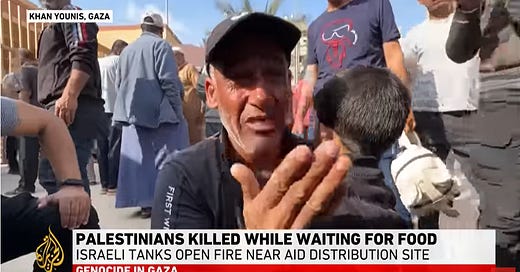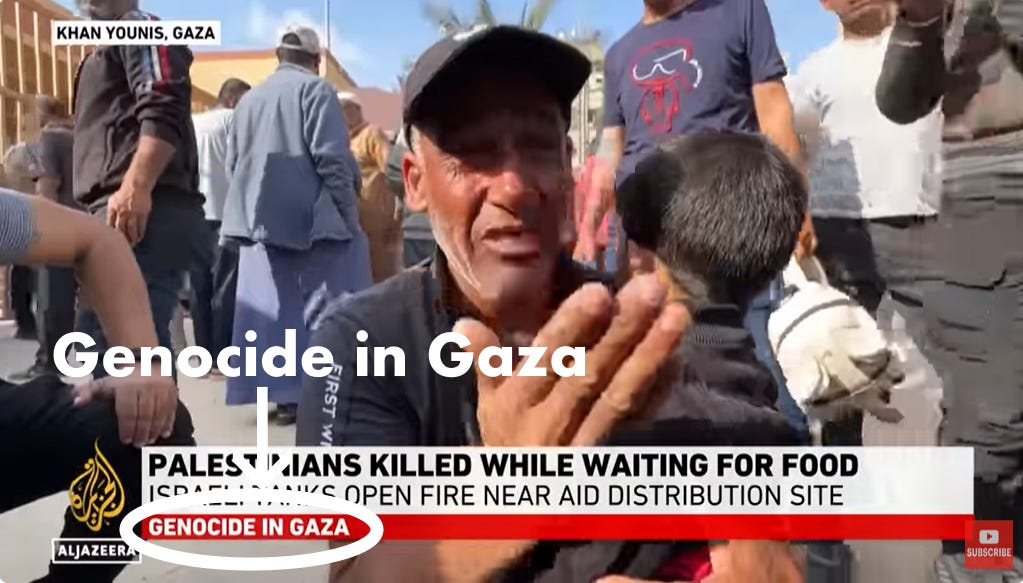The Blood Libel Comes to the Breadline: Manufacturing a Massacre in Rafah
Unraveling the Truth Behind the Gaza Aid Incident
Does this pull on your heart strings?
Here we go again. On 1 June 2025, 31 Palestinians were gunned down near an aid distribution site in Rafah, Gaza, their only crime being hunger in a land choked by siege. The world’s eyes flicker briefly, then turn away to the next big news story.
Let’s not turn yet to the next big story. Let’s examine this one. For me, the most important damning bit is the question of motive. You might want to skip down to that and then come back for the details.
Who broke the news and who swallowed it whole?
The first reports of this “massacre” came from the Hamas-run Gaza Health Ministry. They claimed 31 Palestinians were killed and over 100 injured, allegedly shot by Israeli forces near a US- and Israel-backed Gaza Humanitarian Foundation (GHF) aid site in Rafah. With journalists barred for security reasons (chronic Israel critics will guffaw at this), Gazan civilians who say they witnessed the attack backed it up.
An AP report described the scene:
Thousands of people headed toward the distribution site hours before dawn. As they approached, Israeli forces ordered them to disperse and come back later, witnesses said. When the crowds reached the Flag Roundabout, around 1 kilometer away, at around 3 a.m., Israeli forces opened fire, the witnesses said.
“There was fire from all directions, from naval warships, from tanks and drones,” said Amr Abu Teiba, who was in the crowd.
Reuters also claimed a tank was involved. CNN wrote about a stampede.
An interesting twist came from Sky News:
Witnesses said the deaths came after Israeli forces opened fire at a roundabout near the Gaza Humanitarian Foundation hub, a new aid organisation backed by Israel and the US.
However, Palestinian and Hamas-linked media have attributed the deaths it has reported on to an Israeli airstrike.
It is not yet clear if eyewitnesses and Hamas-affiliated media are giving different accounts of the same incident.
Are they even reporting on the same thing? Meanwhile, Israel denies any attack occurred at all at the aid site.
Blaming Israel for lack of verification
Many reports include a version of this BBC statement:
Israel does not allow international news organisations, including the BBC, into Gaza, making verifying what is happening in the territory difficult.
I suppose this is how they justify publishing Hamas-issued reports upon receiving them. But would the presence of foreign journalists in Gaza have ensured accurate reporting? Hamas inadvertently admitted to intimidating and deporting journalists who did not publish pro-Hamas anti-Israel materials during the war in 2014. To my knowledge, no subsequent corrections have been issued by news outlets once their journalists were safely out of Gaza. This does not inspire confidence in news agencies’ commitment to the truth.
Following Israeli denials
Only after Israel denied the accusations did many news sites add a disclaimer, and their coverage changed minimally. Along with adding descriptions of the videos Israel provided as proof the incident never happened, they wrote that they could not verify the videoclips. I did not see any such qualification regarding either witness reports or Hamas reports.
Also interesting is the fact that there are no videoclips showing even a single IDF tank when multiple reports say that tanks shot at the crowd. If one is going to accuse Israel of shooting at a crowd of hungry Gazans with tanks, or even just one tank, show the tank.
With Hamas’ understanding of the impact of true and false images for spreading lies about Israel, surely there were enough cameras available in the field to record an attack against innocent civilians if one had occurred. One cannot imagine they would have missed this chance.
Israel provided the only videoclip of shooting near a humanitarian aid center that apparently took place on that same day. It shows Hamas militants shooting at their own fellow Gazan civilians approaching an aid site in Khan Younis (and not Rafah).
One thing I find curious in this video is the fact that they seem to be aiming at specific individuals and not randomly at the crowd, something that makes me think of targetted assassinations (but exploring that possibility is beyond the scope of this article).
And this next video is reportedly from the area near the Rafah GHF aid site at the same time as Israel is being accused of attacking the humanitarian aid seekers:
However, the shooting was supposedly at at a short distance from the distribution site so it is unclear to me if this video actually has anything to do with proving or disproving the accusation.
In short, neither videoclip successfully debunks Hamas’ claim of a massacre at the Rafah aid distribution site. However, when there is an accusation of murder, the onus is on the prosecution to prove it happened and not on the defence to prove it did not. You cannot prove a null hypothesis.
An Israeli soldier told the BBC shots were fired near the crowd, not at it, likely to bring a potentially volatile situation under control. It would not be the first time this happened. After all, a crowd of thousands of people coming to collect food for their families when Hamas has been hoarding what was meant for them, could suddenly erupt into pandemonium.
This isn’t Israel dodging accountability—it’s a military operating in a war zone, surrounded by enemies who weaponize lies. Hamas has a history of staging tragedies to smear Israel. Is this that?
The Media’s Spineless Response
Predictably, the mainstream media refused to take a stand. Instead of scrutinizing Hamas’s credibility, they retreated into their familiar “both sides” framing:
BBC News: quoted the IDF, the GHF, and Hamas, without weighing their respective reliabilities.
Reuters: gave equal weight to Israel’s denial and a witness’ emotional testimony.
CNN and The Washington Post: balanced Hamas’ claims with Israel’s denial, as if the truth is decided by tossing a coin.
No outlet had the courage to say it plainly: this might be another Hamas fabrication.
Motives matter
Every murder, in every circumstance, needs a motive.
Why would the IDF shoot civilians coming to collect humanitarian aid for their families at a site erected in conjuction with an American NGO established for that specific purpose? The only plausible reason I can come up with is that this story feeds the false narrative that Israel is committing genocide against the Gazans. We can see that accusation on the bottom banner of an Al-Jazeera new report:
Is that really credible? Even if you believe Israel is committing genocide, does this story really fit?
Come on, Israel haters! You who comment on my articles trying to prove Israel is a genocidal war criminal — give me the reasonable motive for this particular act that would make me reconsider.
On the other hand, Telegram’s Abu Ali Express in English provides a motive — for the Hamas lie:
Hamas is openly working against the new food distribution mechanism because it weakens its power, hence its very strong interest in trying to undermine this humanitarian effort.
Supporting this theory, Abu Ali notes that the “particularly long and detailed statement” on the attack appeared to have been prepared in advance because it is inconceivable that it could have been composed within a half-hour of the first reports.
Moreover, he claims that there is no documentation for the large death toll (beyond AI-generated images or footage of ambulances and injured people that could have been filmed anywhere and at any time in Gaza) and no list of casualties.
Three people separately told reporters that a brother was killed in that incident (Abdullah Barbakh in an al-Jazeera news report, an MSF colleague’s brother reported in the BBC, and Khaled Shurrab in The Washington Post), but nothing official or verifiable has emerged. While it is certainly possible that among the 31 dead, three were brothers of witnesses who spoke to journalists, it just struck me as strange, for some reason.
There is a word for people who repeat lies they haven’t verified, especially when those lies come from a terror group with every reason to manipulate the truth: accomplices. If Hamas has found in the press a willing partner to amplify its fictions, then the tragedy isn’t just in the streets of Rafah—it’s in the newsroom. This wasn’t a massacre. It was a media-assisted blood libel at the breadline.
Because Israel is not supported on the Substack payment platform, I have set up an alternative for those who want to support my work.
You can make one-time or repeated donations in your own currency using Paypal (click image above) or the Ko-fi payment platform here. Israelis can send me a private message for another option.
Articles will always be free for all subscribers but a one-time or repeated donation is a way to help me sustain myself while doing all the work involved in putting these articles together and would be greatly appreciated.
Thank-you to all those who have supported my work by subscribing and/or by donating to my writer’s fund.






Thank you Sheri. It has the too-familiar smell of Hamas propaganda. It makes absolutely no sense that IDF would massacre hungry civilians. IDF has spent the war risking their own lives by telegraphing their strategy so those same people could escape from attacks on terrorist locations. It makes very good sense that Hamas might kill their own citizens and blame Israel. They have done that. It keeps their population under control. It feeds the antisemite press some vile pablum that they thrive on. Will that yellow press also tell us that tanks and navy vessels opened fire as well. Never mind the absurdity of Israel blasting their own humanitarian project. Such weapons would have been devastating and left marks easy to identify. The disturbing thing other than useless loss of life (if it occurred at all) is the drooling and unquestioning publication of more blood libel.
Hamas shoots Gazan civilians trying to get aid from an Israeli-backed aid point and claims the IDF did the shooting. From their perspective, it's a win-win-win:
1) It generates another anti-Israel propaganda narrative.
2) It disposes of a score of people willing to defy Hamas's orders to stay away from the aid point.
3) It dissuades other Gazans from trying to reach the aid point.
Hamas, however, has a problem: it has conditioned Gazans to believe they are in imminent danger of starvation. That makes win #3 much, much weaker because Gazans now think their choice is death by Hamas enforcement or death by starvation. That's the kind of desperation that can break a dictatorship's grip on its population.